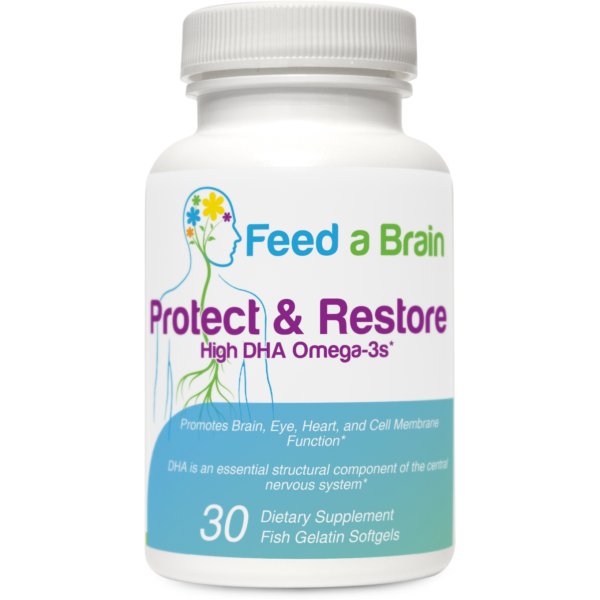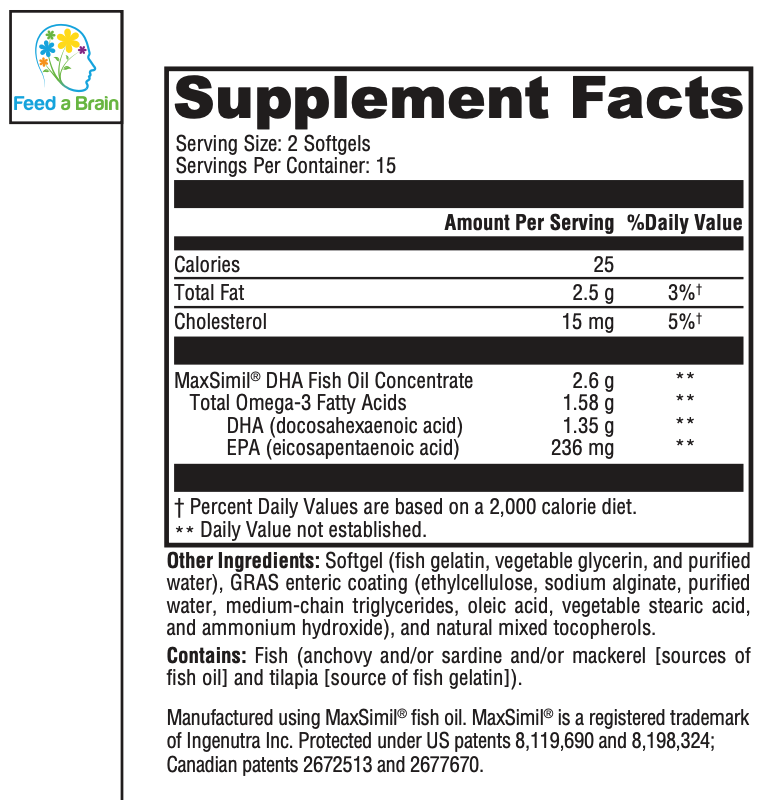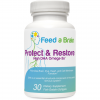Early Brain and Eye Development
Polyunsaturated fatty acids (PUFAs) play a critical role in the normal development of the eye, brain, and central nervous system, and DHA is the most abundant structural fatty acid in these tissues. DHA is transferred directly from mother to fetus during pregnancy, especially during the last trimester, and is available to infants through breast milk. This fatty acid plays a vital role in both prenatal and postnatal brain development. Based on recommendations made by various organizations, pregnant and nursing women should consume 100-300 mg of DHA daily to meet basic fetal and infant needs.*[1,2]
Research indicates that DHA-supplemented and breastfed infants score significantly better on mental and psychomotor development tests and that PUFAs may support normal activity levels and learning capacity during preschool years.[1,3] A study of infants (N = 229) enrolled in three randomized controlled trials suggested that a dose of 0.36% of total fatty acids as DHA (a concentration representative of human breast milk) contributed to favorable problem-solving performance, a parameter found to correlate with later IQ and vocabulary development.[4] **
- Structural role in the brain: DHA is a major structural component of the brain and is found inside cell membranes as phospholipids. It helps maintain the fluidity and integrity of neuronal membranes, which is crucial for proper cell signaling, neurotransmitter release, and overall neuronal function.
- Anti-inflammatory properties: Chronic inflammation is associated with TBI and other neurological disorders, such as Alzheimer’s disease, Parkinson’s disease, and multiple sclerosis. By reducing inflammation, DHA can help protect brain cells from damage and preserve their function.
- Neuroprotective effects: DHA has been shown to help safeguard brain cells against oxidative stress, neurotoxicity, and other damaging processes.
- Promotion of synaptic plasticity: Synaptic plasticity refers to the brain’s ability to modify the strength and structure of connections between neurons; crucial for learning, memory, and overall cognitive function. Another way DHA promoters synaptic plasticity is by influencing various signaling pathways involved in neuronal communication and promoting the growth and branching of dendrites, increasing a neuron’s ability to send and receive signals.
- Role in neurotransmission: DHA is involved in the regulation of mood, cognition, and memory. It influences the release, uptake, and binding of neurotransmitters, such as dopamine, serotonin, and glutamate, which are essential for maintaining optimal brain function.
- Anti-amyloid properties: DHA has been shown to interfere with the formation and accumulation of beta-amyloid plaques, characteristic features of Alzheimer’s disease. By reducing the buildup of these plaques, DHA may help slow down the progression of the disease and preserve cognitive function.
Much of the research on Omega-3’s show DHA specifically to have the most beneficial effects on memory, and brain health. In the Chicago study (5), a strong neuroprotective effect was observed with DHA that was not seen to the same degree with EPA.
Several studies have also shown that people with Alzheimer’s have severely low levels of DHA in key areas of the brain related to memory formation like the hippocampus (6)(7).
- DHA is the most abundant structural fatty acid in the brain and nervous system and plays a vital role in prenatal and postnatal brain development.
- Researchers propose that DHA may play a role in maintaining myelin and neuronal health, supporting healthy eicosanoid metabolism (especially in the brain), and exerting pleiotropic effects to support healthy metabolism and aging.
- Higher DHA levels were significantly associated with better performance in the areas of nonverbal reasoning, mental flexibility, working memory, and vocabulary.
- DHA is recognized for developing and maintaining eye health and function during early life. Optimal retinal and visual cortex maturation were understood to depend upon dietary DHA during development, and visual acuity and mental development were “seemingly improved by extra DHA.”
Enhanced Absorption
DHA is found in fish oils. The production of fish oil concentrates requires converting the fish oil into a form that can be encapsulated. There are typically two different forms of fish oil supplements:
- Ethyl Ester (EE): Using a chemical process called “molecular distillation”, the natural triglyceride form of a fish oil is broken apart and an ethanol molecule is attached to the free fatty acids created. This process allows for a “fish oil concentrate,” but these fish oils lack a glycerol backbone. Because of this the fatty acids are unstable and are looking for an available triglyceride backbone which they may take from an existing molecule in our brain or body. When this occurs, our cells are actually damaged. Additionally, studies have shown that ethyl esters are the least bio-available forms of omega-3’s.(8)
- Triglyceride (TG): Fish naturally contain the omega-3 fatty acids EPA (eicosapentaenoic acid) and DHA (docosahexaenoic acid) as triglyceride esters. Evidence suggests that triglyceride (TG) fish oils are better absorbed in comparison to EEs. And because we can only use what we absorb, absorption is VERY important! So, because they are better absorbed (and because they aren’t creating a domino effect of unstable fatty acids in our bodies), TGs are better than EEs.
Monoglycerides are up to 3.5x better absorbed than triglyceride fish oils!
Our bodies enzymatically break down triglycerides into monoglycerides that we can then use, but Protect & Restore is already enzymatically broken down into its high potency monoglyceride form. This makes Protect & Restore up to 3.5x more absorbable than an equivalent dose of ethyl ester fish oil!
This technology means that the DHA, sourced from cold water fatty fish, has already been pre-digested so that up to 3.5 times the DHA and EPA is able to be readily absorbed by our cells.
Studies conducted by the manufacturer of MaxSimil provide promising results suggesting better absorption than other fish oils. An unpublished, double-blind, crossover, pharmacokinetic study was performed in healthy overnight-fasted male and female subjects (N = 20) ages 19 to 60. Each subject was administered a single dose of six softgels (containing ~2000 mg EPA and ~1500 mg DHA) of either ethyl ester (EE) fish oil or MaxSimil. Compared to the EE form, MaxSimil EPA and DHA reached a peak concentration more than three times higher than that reached by EE fish oil. Moreover, MaxSimil not only reached maximum concentration faster but also maintained plasma levels longer.*[9-11]
1. Singh M. Essential fatty acids, DHA and human brain. Indian J Pediatr. 2005 Mar;72(3):239-42. [PMID: 15812120]
2. Guesnet P, Alessandri JM. Docosahexaenoic acid (DHA) and the developing central nervous system (CNS) – Implications for dietary recommendations. Biochimie. 2011 Jan;93(1):7-12. [PMID: 20478353]
3. Uauy R, Dangour AD. Nutrition in brain development and aging: role of essential fatty acids. Nutr Rev. 2006 May;64(5 Pt 2):S24-33; discussion S72-91. [PMID: 16770950]
4. Drover J, Hoffman DR, Castañeda YS, et al. Three randomized controlled trials of early long-chain polyunsaturated fatty acid supplementation on means-end problem solving in 9-month-olds. Child Dev. 2009 Sep-Oct;80(5):1376-84. [PMID: 19765006]
5. Morris MC, Evans DA, Bienias JL, et al. Consumption of fish and omega-3 fatty acids and risk of incident Alzheimer disease. Arch Neurol. 2003 Jul;60(7):940-6.
6. Soderberg M, Edlund C, Kristensson K, Dallner G. Fatty acid composition of brain phospholipids in aging and in Alzheimer’s disease. Lipids. 1991 Jun;26(6):421-5.
7. Prasad MR, Lovell MA, Yatin M, Dhillon H, Markesbery WR. Regional membrane phospholipid alterations in Alzheimer’s disease. Neurochem Res. 1998 Jan;23(1):81-8.
8. Dyerberg, J., & Bang, H. O. (1979). Hæmostatic function and platelet polyunsaturated fatty acids in Eskimos. The Lancet, 314(8140), 433–435. https://doi.org/10.1016/s0140-6736(79)91490-9
9. Unpublished, internal data. Ingenutra.
10. Fortin S, inventor; Centre de Recherche sur les Biotechnologies Marines, assignee. Compositions comprising polyunsaturated fatty acid monoglycerides or derivatives thereof and uses thereof. US patent 8,198,324. June 12, 2012.
11. Brunet S, Chamoun R, Fortin S, et al. MaxSimil®: A novel, patented natural platform for enhanced absorption of omega-3s. Single dose, double-blind, 2-way crossover pilot pharmacokinetic study on healthy subjects under normal diet. Sherbrooke (Québec), Canada: Ingenutra; 2018. [Unpublished]
DOES NOT CONTAIN: Wheat, gluten, corn, yeast, soy protein, dairy products, shellfish, peanuts, tree nuts, egg, ingredients derived from genetically modified organisms (GMOs), artificial colors, artificial sweeteners, or artificial preservatives.
*The outcome of a systematic review and meta-analysis showed that although omega-3 supplementation does appear to improve childhood psychomotor and visual development, more studies are needed to confirm these conclusions and to explore the significance of IQ later in childhood.
**These statements have not been evaluated by the Food and Drug Administration. This product is not intended to diagnose, treat, cure, or prevent any disease.
See practitioner reference document here.




Reviews
There are no reviews yet.